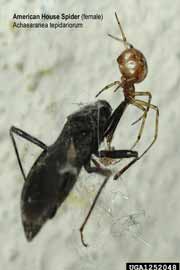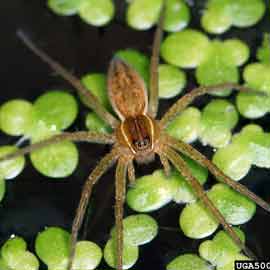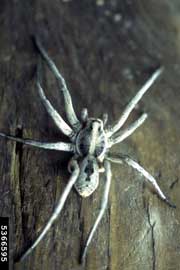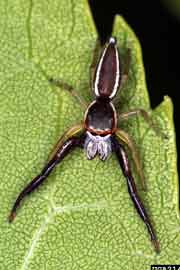Spiders
All spiders are predators. They feed on a wide variety of insects and other soft-bodied invertebrate animals. Spiders attack and subdue their prey by biting with their fangs to inject a venom. As predators, spiders are beneficial, especially when they feed on household and garden insect pests. All spiders are venomous, but few can bite humans and even fewer are potent enough to cause serious health effects.
All spiders spin silk, but the silk is used in a wide variety of ways. Most spiders construct a silken case to protect their eggs, but not all spiders make a web.
Common Spiders in Maine

House spiders (Achaearanea tepidariorum) are common in barns and houses, where they construct webs in the corners of walls, floor joists, and windows. Because they frequently abandon their web to build new ones nearby, they can produce many webs in a short period of time.

Fisher spiders (Family Pisauridae) are also known as fishing spiders or water spiders. They are amphibious and are typically found in moist areas, especially along the edges of streams and lakes. They have the ability to skate across the surface of the water and will even dive beneath the surface to feed on small fish, tadpoles and aquatic insects.

Wolf spiders (Family Lycosidae) hunt at night and are often seen under lights. They run over the ground or on plants in search of prey and pounce upon their victims with vigor and power. They are large, usually brown and black, and may have longitudinal stripes. They frequently enter homes and backyards but pose no danger to people.

Jumping spiders (Family Salticidae) are active hunters during the day, stalking their prey and attacking in a fast leap. They can sometimes be seen dangling from a silken dragline after a leap that fails. Many jumping spiders are bold, stocky and often brightly colored. They are not considered hazardous to humans and are unlikely to bite unless cornered or handled.
Click on images to view full-size
Identification
- Spider Identification and Management Guide—Montana State University
- Spider Eye Arrangements for ID—Bugguide.net picture guide
- Fact Sheet: Spiders—University of Maine Cooperative Extension
- Insect Diagnostic Laboratory: Spiders (PDF)—Cornell University
- Beneficial Insects and Spiders in Your Maine Backyard (PDF)—University of Maine Cooperative Extension
Venomous Spiders in Maine
-
There are no venomous spiders of medical concern that are native to Maine. Occasionally, some species of medical concern can be brought into the state by humans (vehicles, freight, campers, luggage, etc.). The only two species in the US of medical concern are the brown recluse (Loxosceles reclusa) and the black widow (Latrodectus mactans). If think you have been bitten by one of these species, it is recommended that you seek medical attention.
Venomous Spider Resources
- Venomous Spider Factsheets—CDC NIOSH
- False Black Widows—Penn State Extension
- Northern Black Widow—Michigan State University
- Brown Recluse—Penn State Extension
Dig Deeper - Scientific Studies
Integrated Pest Management of the Brown Recluse Spider—Journal of Integrated Pest Management, 2018
Summary: The article reviews the biology and life history of the brown recluse and integrated pest management techniques in areas of its native range. This includes pictures for positive identification, how to monitor for brown recluse, mechanical management through decluttering and sanitation, and a review of insecticides that may be useful.
Think First, Spray Last - Options for Hired Control
In Maine, the Board of Pesticides Control licenses pesticide applicators in several categories. Spider control falls under category 7A (Structural General Pest Control). To find a licensed applicator in your area, and search for category 7A and your county.
[Photos, left to right:Joseph Berger, Bugwood.org; David Cappaert, Michigan State University, Bugwood.org; Eugene E. Nelson, Bugwood.org; David Cappaert, Michigan State University, Bugwood.org]